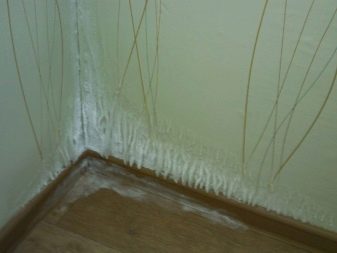The subtleties of the process of external insulation of the corners of the house

Residents of houses very often face the problem of moisture and mold formation on the walls, especially in the corners of houses. This is often due to miscalculations in construction, in which the thermal conductivity of the materials used for the construction and decoration of the house and the internal temperature of the rooms were not taken into account.
Peculiarities
If, in winter, condensation forms on the inner wall of the room in the form of water droplets, and later on - mold, this indicates insufficient thermal insulation of the walls or the material from which they are made.
In addition, in the winter season, with small cracks in the corners, walls and corners can even freeze through due to the flow of very cold air. The reason for this can be both gaps between slabs or bricks, and voids in the slabs themselves.
Due to this unpleasant phenomenon:
- the pasted wallpaper gets wet and falls off;
- walls painted with water-based paint are covered with unpleasant red stains;
- the layer of plaster is gradually destroyed, no matter how strong and high-quality it is;
- fungus and mold appear on the walls.


You can eliminate these shortcomings by insulating the walls from the inside. For example, by laying heating pipes vertically along the corners or by making an additional bevel of plaster in the corners of the room. However, the most effective and efficient way is external insulation of walls and corners, which eliminates the very reason - weak thermal insulation.


Basic ways
The modern industry offers several options for insulation, which differ in the use of a variety of materials and the method of their application.
- Application of "warm" plaster. In this case, foam granules are added to the plaster instead of sand. This significantly reduces the thermal conductivity and the overall weight of the plaster layer. Its use reduces the overall thermal conductivity of walls and corners, while allowing the walls to breathe, which stops the formation of condensation on the walls.
- The use of liquid thermal insulation. Produced by many manufacturers. They are a liquid solution containing microspheres of ceramics, glass or silicone. They have excellent thermal insulation, allow you to work in hard-to-reach places, including in the corners of houses.


- Installation outside of foam blocks, mineral wool or expanded polystyrene. This method has the strongest thermal insulation characteristics, in contrast to the previous two. At the same time, the outside walls of the house are completely covered with light heat-insulating blocks that are not subject to corrosion and have excellent resistance to temperature extremes and high humidity.
- Thickening of brickwork. This very simple and effective method is very often used even at the stage of building houses and visually distinguishes the building in that additional brick laying was carried out at the corners of the houses. Additional installation can be carried out later, if the architecture of the building itself allows it.


How is thermal insulation carried out?
Among the many methods of insulation, everyone chooses their own - the most convenient and affordable option. Most often, walls and corners in corner rooms have to be insulated, since in them, as a rule, two walls go outside the house. At the same time, there are some subtleties when using certain materials.
The very process of warming corners and walls can be performed even at the stage of building a house and design solutions for decorating rooms.For example, only rounding off the inside and outside corners of the facade can reduce the temperature difference between the wall and the air inside the room by up to 20%.
Installing fixtures in plasterboard panels directly in the corners of the room will heat the walls and shift the dew point. This eliminates the cause of the appearance of damp walls in the room.


In addition, during the construction of wooden houses, one should take into account some of the features of log cabins in the "paw" and in the "bowl". So, one of the disadvantages of a "paw" log house is that it is a source of increased heat transfer, and hence heat consumption. As a result, increased cooling of the inner surface of walls and corners, the formation of moisture on their surface.
Using penofol for insulation, it should be borne in mind that the main thing when using it is to create an air cushion between the wall and the material itself. If this condition is not met, then insulation using penofol will not work and will not be able to perform its functions. In addition, when insulated from the outside, the penofol itself sits on three frame support grids.


For reinforcement with foam plastic with the panel method, it is necessary to calculate the area of the material with a thickness of 5–10 cm so that it covers the entire surface of the outer wall with a margin. The cut-to-size panels themselves are fixed to the walls and log cabins using special glue. After all the foam is fixed and the glue has dried, it is necessary to overlap the fiberglass mesh on the foam sheets to give mutual strength to the glued sheets.
Then the foam sheets are covered with a special putty to protect against moisture penetration between the sheets. For the final coating, use a structural putty or facade paint.


With an uncertain source of thermal insulation damage, modern technologies can come to the rescue. In this case, it is necessary to use thermal imaging of the room. Experts in this field will be able to accurately determine the place of violation of thermal insulation and give recommendations on how to eliminate the identified deficiency.
For information on how to properly insulate a house from the outside, see below.













The comment was sent successfully.